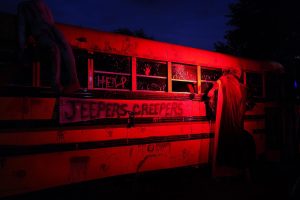Students study Civil War history, culture
December 9, 2016
Junior Travis Frost falls to the ground after “being shot” during drilling exercises at the National Guard Armory. “We [did] Civil War company drills,” Frost said. “[It helped us understand] how the [battle] formations worked.”
In the required U.S. history class, students must learn over 400 years of material, allowing little time to focus on a time period that interests them. However, students in the American Civil War elective have the opportunity to study in depth the political and social causes of the conflict, the military actions, and the results of the battles during this critical time in American history. According to teacher Liz Monseur, students realize how complicated the Civil War really was.
“I want my students to embrace the fact that the war is much more complex than what teachers have time to cover in a typical history class,” Monseur said. “It has left us, as Virginians, living in the middle of its history and trying to preserve the memory of it, bad and good.”
The class had been offered at FHS for years, but registration waned when the previous instructor, Richard Deardoff, left to teach at Kettle Run. Interest in the class renewed, however, and currently 13 students are enrolled. The course begins with the colonial era, rather than the opening shots at Fort Sumter, to help students understand the deep-rooted differences between the north and the south that would ultimately lead to war.
“I think that’s what really surprises students; they have no idea how much these people thought of each other as almost a different species,” Monseur said. “Their value systems were so different.”
Students study Victorian culture and customs, Civil War photography, and soldiering, as well. According to senior William Usrey, the class also provides insight into the parallels between the 1860s and today; racial tensions still exist, and the division between the north and south is still clearly seen.
“[Living] here and living in Georgia, you can see cultural differences, and the tension is still there towards the north. A lot of people in Virginia and Georgia still hate the northerners just as much, but not necessarily for the same reasons, that they did [during the Civil War]. We just see them as very different; the culture is completely different.Everything is a lot more fast-paced the farther you go up north.”
To help students gain a deeper understanding of the war, Monseur uses maps from the era, letters, diary entries and books, and hands-on experience. Monseur brought in a reenactor to teach the class how to drill, using yardsticks instead of weapons. In a field trip to Clark Brothers Gun Shop, students were able to shoot replica Springfield .58 caliber rifled muskets from 1861, and Monseur plans to teach dances from the era later in the course. The class took a walking tour of Warrenton, which changed hands 67 times over the course of the conflict, to learn about the Civil War’s impact on local history.
Most recently, the class took a field trip to Gettysburg, the site of one of the most important and pivotal battles of the war. Deardoff accompanied the class to give students a greater understanding of the battle.
“He knows everything about the Civil War,” senior Sarah Kamphuis said. “Hearing him tell all of these funny stories about it, and actually being there on the battlefield and seeing the monuments, was just really interesting. It just kind of ties everything that you’ve learned together.”
According to Kamphuis, the class increased her knowledge of the Civil War and her understanding of the two sides.
“We kind of live in an awkward location because we’re not like the north and we’re not like the south,” Kamphuis said. “We are kind of in the middle, and it’s hard for us to understand both sides, but now I feel like I understand both sides and the Civil War makes a lot more sense to me.”
The class has helped Usrey understand the complexity of the war, since there wasn’t a true “good” or “bad” side.
“You grow up in elementary school with them saying the north was good and the south was bad, and the south had slavery and that’s why they were bad, but that’s not it at all,” Usrey said. “The [northerners were] still horrible racists; they just didn’t have slavery. It’s just a much bigger understanding of the reasons they did what they did.”







